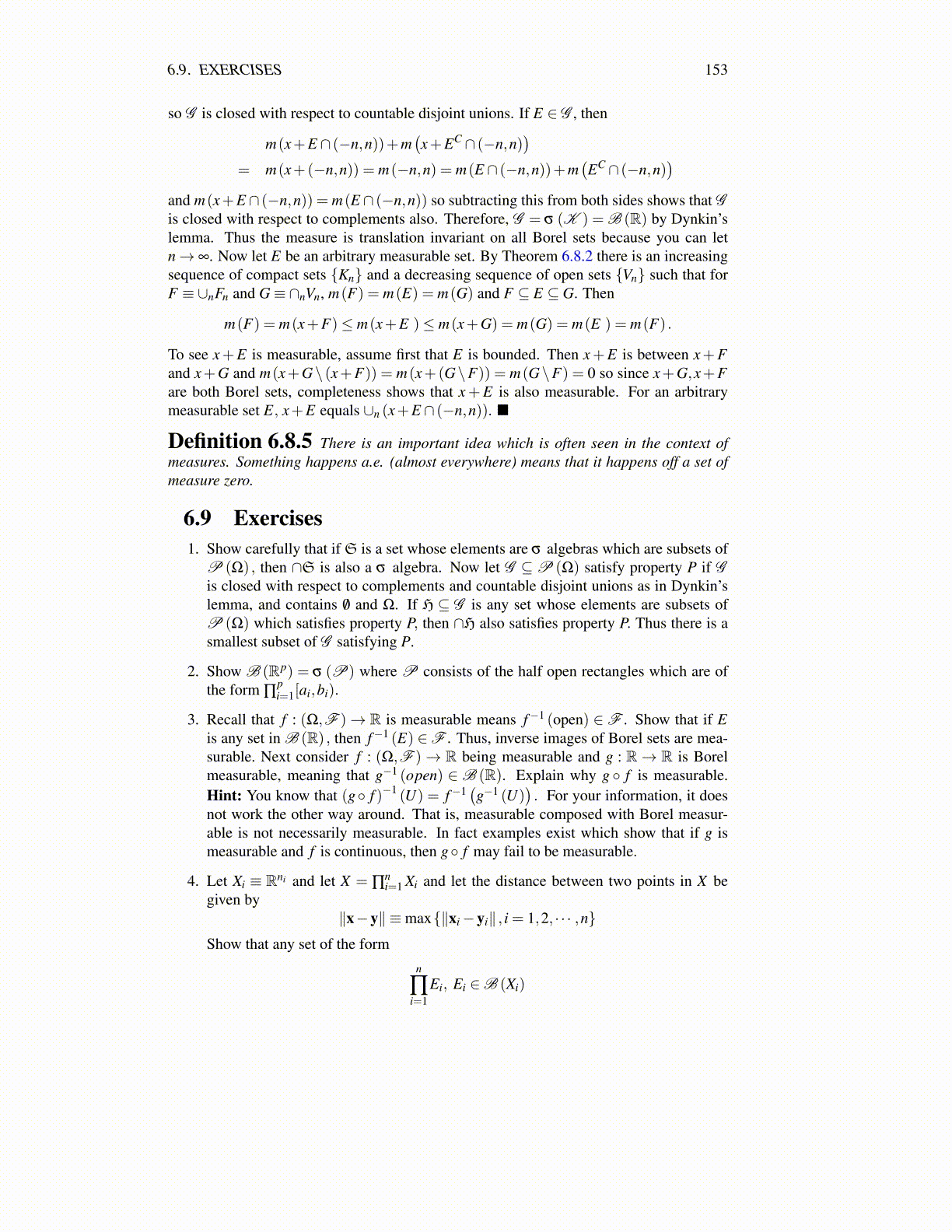
6.9. EXERCISES 153
so G is closed with respect to countable disjoint unions. If E ∈ G , then
m(x+E ∩ (−n,n))+m(x+EC ∩ (−n,n)
)= m(x+(−n,n)) = m(−n,n) = m(E ∩ (−n,n))+m
(EC ∩ (−n,n)
)and m(x+E ∩ (−n,n)) = m(E ∩ (−n,n)) so subtracting this from both sides shows that Gis closed with respect to complements also. Therefore, G = σ (K ) = B (R) by Dynkin’slemma. Thus the measure is translation invariant on all Borel sets because you can letn→ ∞. Now let E be an arbitrary measurable set. By Theorem 6.8.2 there is an increasingsequence of compact sets {Kn} and a decreasing sequence of open sets {Vn} such that forF ≡ ∪nFn and G≡ ∩nVn, m(F) = m(E) = m(G) and F ⊆ E ⊆ G. Then
m(F) = m(x+F)≤ m(x+E )≤ m(x+G) = m(G) = m(E ) = m(F) .
To see x+E is measurable, assume first that E is bounded. Then x+E is between x+Fand x+G and m(x+G\ (x+F)) = m(x+(G\F)) = m(G\F) = 0 so since x+G,x+Fare both Borel sets, completeness shows that x+E is also measurable. For an arbitrarymeasurable set E, x+E equals ∪n (x+E ∩ (−n,n)). ■
Definition 6.8.5 There is an important idea which is often seen in the context ofmeasures. Something happens a.e. (almost everywhere) means that it happens off a set ofmeasure zero.
6.9 Exercises1. Show carefully that if S is a set whose elements are σ algebras which are subsets of
P (Ω) , then ∩S is also a σ algebra. Now let G ⊆P (Ω) satisfy property P if Gis closed with respect to complements and countable disjoint unions as in Dynkin’slemma, and contains /0 and Ω. If H ⊆ G is any set whose elements are subsets ofP (Ω) which satisfies property P, then ∩H also satisfies property P. Thus there is asmallest subset of G satisfying P.
2. Show B (Rp) = σ (P) where P consists of the half open rectangles which are ofthe form ∏
pi=1[ai,bi).
3. Recall that f : (Ω,F )→ R is measurable means f−1 (open) ∈F . Show that if Eis any set in B (R) , then f−1 (E) ∈F . Thus, inverse images of Borel sets are mea-surable. Next consider f : (Ω,F )→ R being measurable and g : R→ R is Borelmeasurable, meaning that g−1 (open) ∈ B (R). Explain why g ◦ f is measurable.Hint: You know that (g◦ f )−1 (U) = f−1
(g−1 (U)
). For your information, it does
not work the other way around. That is, measurable composed with Borel measur-able is not necessarily measurable. In fact examples exist which show that if g ismeasurable and f is continuous, then g◦ f may fail to be measurable.
4. Let Xi ≡ Rni and let X = ∏ni=1 Xi and let the distance between two points in X be
given by∥x−y∥ ≡max{∥xi−yi∥ , i = 1,2, · · · ,n}
Show that any set of the form
n
∏i=1
Ei, Ei ∈B (Xi)